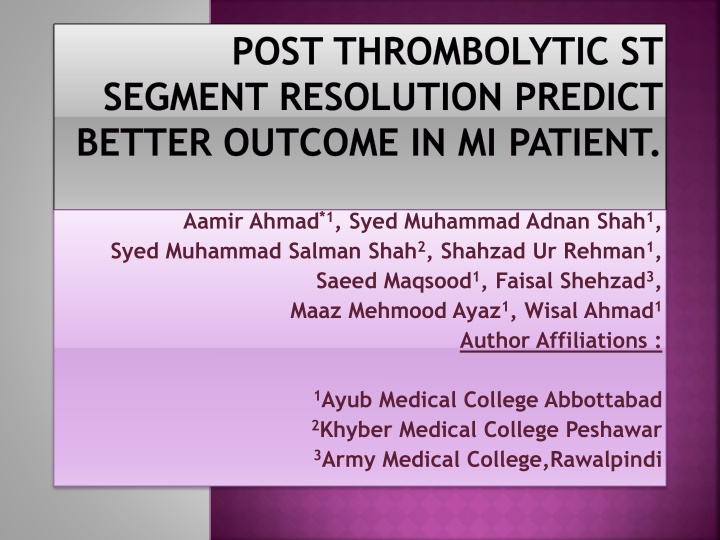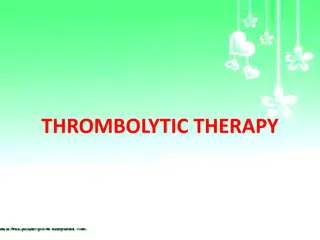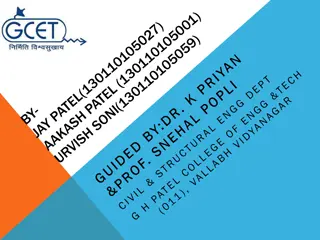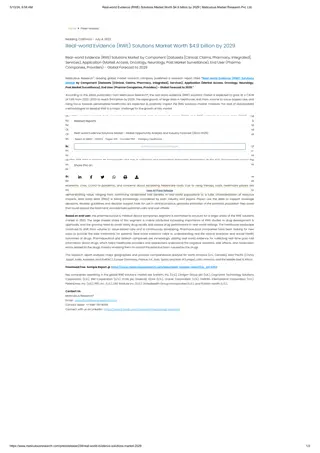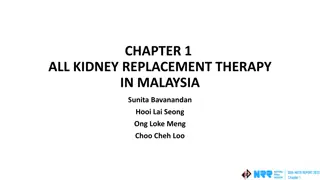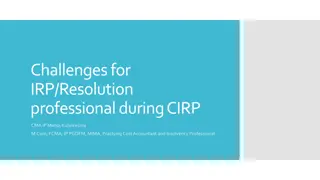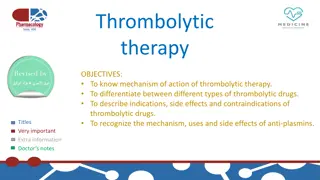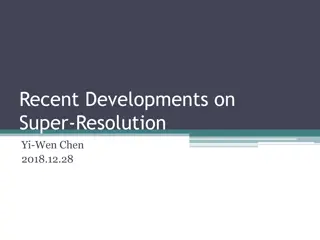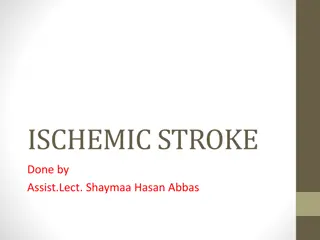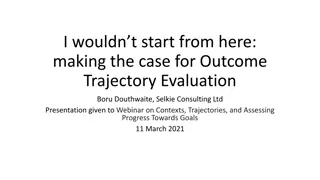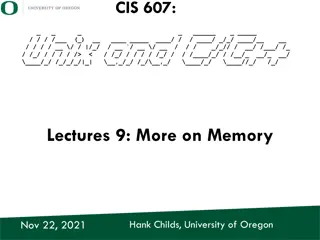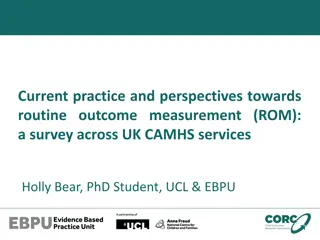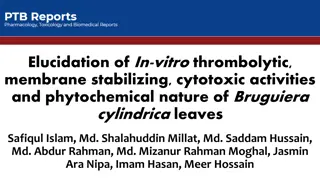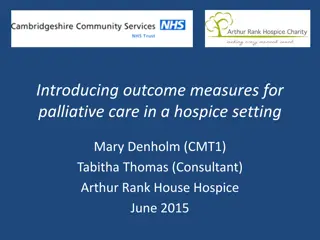Thrombolytic ST Segment Resolution Predicts Better Outcome in MI Patients
Acute myocardial infarction (AMI), commonly known as a heart attack, occurs when blood flow to a part of the heart is blocked, leading to heart muscle injury. Resolution of ST segment elevation on electrocardiogram after thrombolytic therapy can predict final infarct size, left ventricular function, and clinical outcome. This study explores the implications of ST segment non-resolution post-thrombolytic therapy in assessing coronary reperfusion effectiveness.
Download Presentation

Please find below an Image/Link to download the presentation.
The content on the website is provided AS IS for your information and personal use only. It may not be sold, licensed, or shared on other websites without obtaining consent from the author.If you encounter any issues during the download, it is possible that the publisher has removed the file from their server.
You are allowed to download the files provided on this website for personal or commercial use, subject to the condition that they are used lawfully. All files are the property of their respective owners.
The content on the website is provided AS IS for your information and personal use only. It may not be sold, licensed, or shared on other websites without obtaining consent from the author.
E N D
Presentation Transcript
POST THROMBOLYTIC ST SEGMENT RESOLUTION PREDICT BETTER OUTCOME IN MI PATIENT. Aamir Ahmad*1, Syed Muhammad Adnan Shah1, Syed Muhammad Salman Shah2, Shahzad Ur Rehman1, Saeed Maqsood1, Faisal Shehzad3, Maaz Mehmood Ayaz1, Wisal Ahmad1 Author Affiliations : 1Ayub Medical College Abbottabad 2Khyber Medical College Peshawar 3Army Medical College,Rawalpindi
INTRODUCTION: METHODS: STATISTICAL ANALYSIS: RESULTS: DISSCUSION: CONCLUSIONS: AKNOWLEDGEMENTS:
INTRODUCTION Acute myocardial infarction (AMI) is the medical term for an event commonly known as a heart attack. An MI occurs when blood stops flowing properly to a part of the heart, and the heart muscle is injured because it is not receiving enough oxygen. Usually this is because one of the coronary arteries that supplies blood to the heart develops a blockage due to an unstable buildup of white blood cells, cholesterol and fat. Myocardial infarction is a common presentation of coronary artery disease. The World Health Organization estimated in 2004, that 12.2% of worldwide deaths were from ischemic heart disease; with it being the leading cause of death in high- or middle-income countries and second only to lower respiratory infections in lower- income countries. Worldwide, more than 3 million people have STEMIs and 4 million have NSTEMIs a year. STEMIs occur about twice as often in men as women. In patients with evolving myocardial infarction, an early prognostic indicator that is easy to use in all patients is highly desirable. In only a few studies has resolution of electrocardiographic (ECG) ST segment elevation been tested as a prognostic indicator (1-3)in contrast to coronary reperfusion predicted by ST segment changes, which has been investigated by numerous investigators (4). Resolution of ST segment elevation has been shown to be a simple and useful predictor of final infarct size, left ventricular function, and clinical outcome after both thrombolytic and Interventional approaches to the management of acute myocardial infarction (5 7). It is known that a patent epicardial artery does not necessarily result in reperfusion at a cellular level, and it has been suggested that ST segment recovery may be a better marker of myocyte reperfusion (8 10).
INTRODUCTION INTRODUCTION Thrombolytic therapy for acute myocardial infarction (MI) reduces case fatality and improves clinical outcomes(11-12). However, in up to 60% of patients the thrombolytic therapy does not restore perfusion in the myocardium at risk (13) and such failure indicates a worse prognosis (14). Analysis of ST-segment resolution on ECG, after fibrinolytic therapy, in cases of ST elevation Myocardial Infarction offers an attractive and cost effective solution to assess coronary reperfusion. Schroeder et al (15) reported that absence of ST segment resolution was the most powerful independent predictor of early mortality (p = 0.0001).Since ECG is widely available even in developing nations, it is important to establish its effectiveness as a tool for assessing reperfusion as it will offer the cheapest alternative for assessing recovery and myocardial salvage. We investigated the implications of ST segment non-resolution after thrombolytic therapy and found differences in ST segment elevation resolution as a measure of the differential effectiveness of thrombolytic regimens.
METHODS: Study Patients: This comparative study was conducted at Cardiology Unit of Ayub Teaching Hospital, Abbottabad, from April 2013 to October 2013.One hundred fifteen patients with ST elevation myocardial infarction were included in the study. The diagnosis of Myocardial Infarction was based on WHO criteria for acute myocardial infarction i.e. presence of any two of the following: 1) Clinical history of ischaemic type chest pain lasting for more than 20 minutes, 2) Electrocardiography changes i.e. Segment elevation >0.2mv in at least two contiguous chest leads or >0.1mv in at least two contiguous limb leads, 3) New or presumably New left bundle branch block on Electrocardiogram and 4) raised levels of cardiac enzymes CPK-MB more than double of the reference value or positive Troponin I test done with commercially available kits of Trop I.
METHODS: Patient s Electrocardiographic analysis: A baseline 12-lead electrocardiogram was recorded before initiation of thrombolysis and at 90 minutes thereafter. The lead with maximum ST segment elevation in the initial record was used for comparison. ST segments were measured by lens-intensified caliper at 60 ms beyond the J-point, retrospectively by a single independent observer blinded to clinical outcomes. Data collection: A detailed history was taken and recorded in specially designed questionnaire form particularly of age, sex, occupation, address, history of smoking, Diabetes Mellitus, hypertension and family history of hypertension and Obesity. Complete physical examination of patients was done upon presentation in Emergency and important parameters such as pulse and blood pressure were noted. Patients were followed up daily. Pulse, ECG changes and complications if any, were monitored till death or discharge of the patient. Follow up was conducted for each patient throughout his or her hospital stay. The major complications noted were Arrhythmias, Cardiogenic Shock, Aneurysm, Acquired VSD, and Mortality.
METHOD Ethics The sample of 115 subjects was considered to be sufficient for this study, which adhered to the principles of the Declaration of Helsinki, and was approved by independent ethics committee of Ayub Teaching Hospital Abbottabad. We obtained written informed consent in all cases to participate in the study.
STATISTICAL ANALYSIS: Statistical analysis was done using SPSS 16.0 for Windows. Data is expressed as mean (SD). A probability value of p<0.05 was considered significant. Chi- Square test was used to compare the demographic characteristics and complications in both groups. We used 0.05% level of significance.
RESULTS: A total of 115 patients were enrolled in the study, of these 82% were male and 18% were female. The overall mean age of the study participants was 56.19 1.36 years. The baseline clinical characteristics of the patients are given in table 1.
BASELINE CLINICAL CHARACTERISTICS OF THE PATIENTS Demographic Characteristics ST-resolution present (gp. A) n=102 54.70 12.66 ST-resolution absent (gp. B) n=13 67.84 15.70 Mean Age (St deviation) Gender Male=83 , Female=19 23 (23%) 76 (75%) 59 (58%) Male=11 , Female=2 4 (31%) 7 (54%) 12 (92%) Diabetes Mellitus Hypertension Family History Hypertension Smoking Obesity 44 (43%) 23 (23%) 5 (38%) 2 (15%)
On the basis of our ECG criteria for successful/ unsuccessful thrombolysis, these 115 patients were divided into two groups, i.e., successful thrombolysis group (group A) and unsuccessful thrombolysis group(group B).Group A included 102 (89%) patients and group B included 13 (11%).The mean age in Group A was 54.70 12.66 years while in group B was 67.84 15.70 years. The history of hypertension, obesity and smoking was more common in group A, while history of Diabetes Mellitus and Family history was more common in group B. In group A, 1 (1%) patient developed complications during their follow up in the hospital. While in group B, 13 (100%) patients developed complications during their hospital stay.The most common complications were cardiogenic shock and arrhythmias. Table 2 shows the distribution of complications between the two groups.
DISTRUBUTION OF COMPLICATIONS Complication ST resolution Present (n=102) 0 (0%) ST resolution Absent (n=13) P value Cardiogenic Shock Arrhythmias Aneurysm Acquired VSD Death 8(62%) <0.001 1(1%) 0(0%) 0(0%) 5(38%) 0(0%) 0(0%) <0.001 0(0%) 0(0%)
Most of complication occurred in group B. The most common complication observed in group B was cardiogenic shock, accounting for 8 (62%) patients while arrhythmias were accounting for 5 (38%) patients. In group A only one patient suffered from complications of arrhythmias.
DISSCUSION: This study spotlights the inferior clinical outcome of patients with no ST-segment resolution after thrombolytic treatment, denoted by simple evaluation of the post thrombolysis electrocardiogram. Historically, ST segment resolution has been one of the indicators utilized to assess reperfusion in ST Elevation Myocardial Infarction in the past. . Its significance cannot be declined as a prognostic indicator and the inference of our study also strengthens this fact. Ideally, an early predictive indicator in patients with acute myocardial infarction should be unmingled, hasty, noninvasive and comfortable to apply in all patients. An assessment by ECG criteria would satisfy all of these proclaims. Patients with complete ST segment resolution may be scheduled for early discharge without routine angiography Only patients with doubted comprehensive coronary artery disorder and those with recurring ischemia or stress test results suggestive of ischemia should be contemplated for angiography and revascularization management. In patients with lack of ST segment resolution, identifying those patients who have a poor prognosis without reperfusion and patients in whom reperfusion might be expected to provide substantial benefit, early angiography and revascularization may be indicated (16).
DISSCUSION: In our study, thrombolysis was successful in terms of ST-segment resolution in 89% of patients which is more in comparison to a study by Bhatia et al(17), GUSTO-I trial(18), Lee et al(19), Goldhammar et al(20) and Sher Bahadar et al (21) where it was successful in 53%, 54%, 43.2% ,56.4% and 68% respectively. The better result in our study could be due to early diagnosis, and lesser door to needle time, as our hospital is located in the center of the city. Our inference prove the occurrence of complications, in patients who revealed ST resolution ninety minutes after management with streptokinase, to be 1% while the occurrence of complications in patients without ST resolution was 100%, the rate in the latter being essentially higher. This finding therefore institutes a straightforward relation between ST resolution and the frequency of complications. These findings are more in comparison to a study by Bhatia et al and Shuja et al(22) where it was 38% and 35% respectively developed in patients with ST Resolution compared to 83% and 81% of the patients respectively from the non - ST resolution group (P<0.001) .The study carried out by Aderson RD et al(23) showed that presence or absence of ST resolution after thromobolysis therapy is a useful predictor of mortality in post myocardial infarction patients.
DISSCUSION: Heart failure is the major determinant of prognosis of myocardial infarction and the most commonly observed complication in this study. In our inference we observed that the occurrence of Heart failure was 0% in patients with ST resolution and 62% in patients without ST resolution (p<0.001) during follow up. Our results are assisted by the findings of a study done by by Shuja et al.They observed that the incidence of Heart failure was 27% in patients with ST resolution and 62% in patients without ST resolution (p<0.001).SCHRODER(24) et al also replicates our findings. Lee SG et al (25) carried out a study to emphasize the relation between ST resolution and left ventricular recovery. Their results showed that in patients with ST segment resolution left ventricular ejection fraction and muscle contractility improved significantly. While patients who did not show any ST resolution, changes relating to LV function were insignificant thus there was no improvement in LV function. They comprehended that ST segment resolution is associated with restoration of normal LV systolic function and prognosis.
DISSCUSION: We observed arrhythmias in 38% of the patients who had no ST resolution whereas 1% experienced arrhythmias in the ST resolution group. The results clearly show that arrhythmias are less frequent in patients who show ST resolution in their post Streptokinase ECG. Again our study is strongly supported by Shuja et al. They observed arrhythmias in 32% of the patients who had no ST resolution whereas 10% experienced arrhythmias in the ST resolution group. A multi-variant analysis is demanded to expel the significance of confounding element such as age, gender, number of coronary risk factors bestowed by the subject, usage of aspirin within 7 days, and numerousness of angina assaults the patients' endured. Another limiting factor was the non-randomized nature of the research and small size of patients included in the study. The ST segment after acute myocardial infarction is continuous dynamic process, and our use of static measurements could have led to errors in categorizing of patients as successful or unsuccessful reperfusion. In adjunct to this it was also narrowed by the actuality that it was a single center study and the researchers lacked experience.
DISSCUSION: From this study we comprehend that the routine evaluation of ST- segment resolution after thrombolysis for myocardial infarction, conjugated with other clinical markers, might ease the choice of patients who can safely be discharged timely. Different extents of ST segment resolution may assist as a precise subrogate termination step in clinical trials.
CONCLUSIONS: The inference assists the assumption that ST resolution is a substitute marker of tissue level reperfusion. Our study backs the record that ST resolution is a serviceable and a trustworthy marker for evaluating micro-vascular perfusion. This simple, noninvasive supervise technique may be of supplemental prognostic importance in the early period after acute myocardial infarction, when fast decision making belong to the management of these patients is required. The amount of ST segment resolution within ninety minutes after the startle of thrombolytic therapy convoy very beneficial information concerning the outcome in patients with acute myocardial infarction.
AKNOWLEDGEMENTS: We thank Dr. WaqarAhmad Mufti M.Sc Cardiology (Glasgow), FRCP (Glasgow) and all coronary care unit staff for help with the collection of data. Competing interests: We have no competing interest associated with this paper.
REFERENCES 1. Saran RK, Been M, Furniss SS, Hawkins T, Reid DS. Reduction in STsegment elevation after thrombolysis predicts either coronary reperfusion orpreservation of left ventricular function. Br Heart J 1990;64:113-7. 2. Barbash GI, Roth A, Hod H, et al. Rapid resolution of ST elevation andprediction of clinical outcome in patients undergoing thrombolysis withalteplase (recombinant tissue-type plasminogen activator): results of theIsraeli Study of Early Intervention in Myocardial Infarction. Br Heart J1990;64:241-7. 3. Mauri F, Maggioni AP, Franzosi MG, et al. A simple electrocardiographicpredictor of the outcome of patients with acute myocardial infarction treatedwith a thrombolytic agent. A GISSI-2 derived analysis. J Am Coil Cardiol1994;24:600-7. 4. Dissmann R, Schr6der R, Busse U, et al. Early assessment of outcome byST-segment analysis after thrombolytic therapy in acute myocardial infarction.Am Heart J 1994;128:851-7. 5. Pepine CJ. Prognostic markers in thrombolytic therapy: looking beyondmortality. Am J Cardiol 1996;78:24 7. 6. de Lemos JA, Braunwald E. ST segment resolution as a tool for assessing theefficacy of reperfusion therapy. J Am Coll Cardiol 2001;38:1283 94. 7. Angeja BG, Murphy AS, et al. TIMI myocardial perfusion gradeand ST segment resolution: association with infarct size as assessedby single photon emission computed tomography imaging. Circulation2002;105:282. 8. Taniyama Y, Higashino Y, Fujii K, et al. Myocardial perfusion patterns relatedto thrombolysis in myocardial infarction perfusion grades after angioplasty inpatients with acute anterior wall myocardial infarction. Circulation1996;93:1993 9. 9. Porter RT, Shouping L, Oster R, et al. The clinical implications of no reflowdemonstrated with intravenous perfluorocarbon containing microbubblesfollowing restoration of thrombolysis in myocardial infarction (TIMI) 3 flow inpatients with acute myocardial infarction. Am J Cardiol 1998;82:1173 7.
REFERNCES 10. van t Hof AWJ, Liem A, de Boer M-J, et al. Clinical value of 12-leadelectrocardiogram after successful reperfusion therapy for acute myocardialinfarction. Lancet 1997;350:615 19. 11. Gruppo Italiano per lo Studio della Streptochinasi nell InfartoMiocardico (GISSI). Effectiveness of intravenous thrombolytictreatment in acute myocardial infarction. Lancet 1986;i:397 402 12. ISIS-2 (Second International Study of Infarct Survival) CollaborativeGroup. Randomised trial of intravenous streptokinase, oral aspirin,both, or neither among 17,187 cases of suspected acute myocardialinfarction: ISIS-2. Lancet 1988;ii:349 60 13. de Belder MA. Coronary disease: acute myocardial infarction: failedthrombolysis. Heart 2001;85:104 12 14. Group FTTFC. Indications for fibrinolytic therapy in suspected acutemyocardial infarction: collaborative overview of early mortality and major morbidity results from all randomized trials of more than 1000patients. Lancet 1994;343:311 22 15. Schr der R, Dissmann R, Br ggemann T, Wegscheider K, Linderer T, TebbeU, Neuhaus KL. Extent of early ST segment elevation resolution: a simple butstrong predictor of outcome in patients with acute myocardial infarction. J AmColl Cardiol 1994;24: 384-91. 16. Ellis SG, Ribeiro da Silva E, Heyndrickx G, et at. Randomized comparisonof rescue angioplasty with conservative management of patients with earlyfailure of thrombolysis for acute anterior myocardial infarction. Circulation1994;90:2280-4. 17. Prendergast BD, Shandall A, Buchalter MB. What do we do when thrombolysis fails? A United Kingdom survey. Int J Cardiol 1997;61:39 42. 18. An international randomized trial comparing four thrombolyticstrategies for acute myocardial infarction. The GUSTOinvestigators. N Eng J Med 1993;329:673 82. 19. Lee YY, Tee MH, Zurkurnai Y, Than W, Sapawi M, Suhairi I.Thrombolytic failure with streptokinase in acute myocardial infarction using electrocardiogram criteria. Singapore Med J2008;49:304 10. 20. Goldhammer E, Kharash L, Abinader EG. Circadian fluctuationsin the efficacy of thrombolysis with streptokinase. Postgrad MedJ 1999;75:667 71.
REFERNCES 21.Sher Bahadar Khan, Rafiullah*, Lubna Noor, Khurshid Ahmad, Yasir Adnan, Amber Ashraf,Asif Iqbal, Hafiz ur Rehman, Mohammad Hafizullah COMPARATIVE ANALYSIS OF TYPE OF MYOCARDIAL INFARCTIONIN PATIENTS WITH SUCCESSFUL OR UNSUCCESSFULSTREPTOKINASE THROMBOLYSIS FOLLOWING ST ELEVATIONMYOCARDIAL INFARCTION J Ayub Med Coll Abbottabad 2012;24(1) 22.Shuja-ur-Rehman1, Sidrah Sheikh, Mohsin NazeerST segment resolution post MI-a predictor of better outcomes J Pak Med Assoc. 2008 May;58(5):283-6. 23.Anderson RD, White HD, Ohman EM, Wagner GS, Krucoff MW, ArmstrongPW, et al. Predicting outcome after thrombolysis in acute myocardialinfarction according to ST-segment resolution at 90 minutes: a sub-study ofthe GUSTO-III trial. Global Use of Strategies To Open occluded coronaryarteries. Am Heart J 2002; 144: 81-8. 24.ROLF SCHRODER, MD, FACC, KARL WEGSCHEIDER, PHD, KLAUS SCHRODER, MD,RIADIGER DISSMANN, MD, WOLFGANG MEYER-SABELLEK, MD, Extent of Early ST Segment Elevation Resolution: A Strong Predictorof Outcome in Patients With Acute Myocardial Infarction and aSensitive Measure to Compare Thrombolytic RegimensA Substudy of the International Joint Efficacy Comparison of Thrombolytics JACC Vol. 26, No. 7 December 1995:1657-64(INJECT) Trial 25. Lee SG, Cheong JP, Shin JK, Kim JW, Park JH. Persistent ST-segment elevation after primary stenting for acute myocardial infarction: its relation toleft ventricular recovery. Clin Cardiol 2002; 25: 372-7.
The best and most beautiful things in the world cannot be seen or even touched - they must be felt with the heart. Helen Keller THANK YOU VERY MUCH
